
 |
Since the art of making it becomes a huge aspect of the making of art, TINSQUO has created an ongoing feature called "What It Takes." The W.I.T. interviews explore different artist’s applications of will in forging a successful artistic life in New York City and beyond.
ECHOES ALONG THE COLLECTIVE URBAN HOLLER
Jenny Scheinman’s violin has played a dizzying dance of collaboration with with the current greats of New York’s Downtown New Jazz scene: from John Zorn to Norah Jones, she’s played her way into a rising reputation as a talent to watch.
Last month, in between her gigs with Jones, guitarist Bill Frisell and preparations for a mid-November tour with Madeleine Peyroux, Scheinman managed to squeeze in two mesmerizing cd release parties for her own new work, 12 Songs, one at Tonic (with a fifteen piece orchestra) and the other at the Jazz Standard (in duet with Frisell).
If you’ve never heard Jenny Scheinman’s nuanced and atmospheric compositions, they can provide surprisingly unnostalgic entrance to the raw character and sound of America’s past. Yet, hers are not the works of an artist longing for some yesteryear. They echo what is vital in this country’s Irish, Folk and Jewish fiddle traditions, stringing along lazy streams, pooling into the jazz manouche of San Francisco’s ‘90s Django Reinhardt revival and picking up speed along an underground current that wells up from the collective urban holler.
With six cds of her own work in just over as many years and a solid reputation as a great side person, TINSQUO wonders what it takes to maintain a music-only income while remaining one’s own producer and where Jenny hopes to go from here.
TINSQUO was introduced to the violinist under novel circumstances: hearing her sing a night of early 20th century folk compositions with some Willie Nelson mixed in during her monthlong vocalist debut at Ludlow St.’s acoustic enclave, The Living Room.
TINSQUO: Did stepping into the lead vocalist spotlight affect your ideas about how to “sing” with the violin?
SCHEINMAN: Singing made me want to look at the audience, made it really clear that I was saying something to them. Whereas back on the violin, I felt much farther away from everyone; I felt relatively alienated. I also remember at one moment being filled with hope that music can, in fact, bring people together and bringing that optimism back into my instrumental work is energizing.
Your question is interesting though - how did it feel to return to the violin after singing? At moments, it felt powerless. Even as a fledgling singer, I felt empowered singing into the mic. I felt like I could gather the energy in the room.
I'm amazed at the inherent emotional power of the human voice: when a singer takes the stage, she takes it with such power, such a different power than an instrumentalist.
Like so many other jazz musicians, I've been trying to find my way into that power as an instrumentalist. So, the singing project was more research into the boundaries that can or cannot be crossed - the similarities and differences that can or cannot be erased between a singer and an instrumentalist.
Naturally, I was terrified before my first gig as a singer but pushed myself to do it in order to see how it might affect and infect my violin playing.
TINSQUO: Are you a composer of habit or chaotic habit? When do you create your best work?
SCHEINMAN: Sometimes I'm able to just sit down and make myself write. For example, 12 Songs came out of an assignment to write twelve melodies a day. After two weeks, I had something good.
Then, there are the magic times of just hearing stuff on the subway and scrambling for a scrap of paper to write it down. The follow through is the key - whether that’s holding on to the scrap of paper or carefully looking through the piles of notes to find the real ones. I don't really do well under pressure - like if someone wants something for something, this is a kind of pressure that is not constructive to me.
TINSQUO: You've mentioned your “luck” at having been able to avoid the day job and your site's brief autobiography is compelling reading from the early years. What is the present process by which you engage the nuts and bolts of making a living as a musician?
SCHEINMAN: I still say, ‘yes,’ to almost everything. I'm pretty happy if I'm challenged by a situation. I can be playing music I don't even particularly like - music that I wouldn't want to listen to - and, if its difficult in some way, then I'm pretty happy. So, I'm versatile and flexible.
TINSQUO: Nuts and bolts?
SCHEINMAN: I answer the phone and say, ‘Yes,’ and even if its not a gig that blows my mind, it usually, eventually, leads to something and I always learn something.
TINSQUO: What do you wish someone had told you about this business when you
were 18?
SCHEINMAN: Right now, what I need to hear is that I don't need to please anyone in particular but I've got to go straight into what it is that I hear and find the power inside. We should have another interview in twenty years and I'll answer all the same questions again. I think I would answer this one with more perspective.
TINSQUO: One of the things you said at the Jazz Standard 12 Songs party stays in mind: “All of the labels I want to work with come to see me but they haven’t signed me.” Do you feel it is important to somehow define yourself beyond your music or have some clearer vision of who you are musically in order to get signed by a label?
SCHEINMAN: I don't know what you mean by define myself beyond my music. Maybe I'm too diverse? Maybe record companies can't figure out who I really am or maybe record companies (as everyone always says) are having a hard time and can't take anyone new on. [shrugs]
Hey, wanna be my manager?
I am ready for a [big] label. I don't hustle. I make my presence known through playing and do my small bit to send out email notices, make records, hire a publicist for a few months when my record comes out.
Four of my records have come out on labels: the first on Avant, the second and third on Tzadik and this last one on Cryptogramophone. These are all wonderful labels and I feel especially lucky to have been supported by them. The thing that these small labels just can't afford is tour support and large scale publicity campaigns - to not only make my record available to lots of people but make ME available to lots of people.
John Zorn (who runs Avant and Tzadik) is totally straightforward and with money, challenging and passionate. Though we sometimes disagree, he - for the most part - gave me the freedom to make the records that I wanted to make.
This is also true of Jeff Gauthier, the owner of Cryptogramophone. Like Zorn, he gave me nearly total artistic freedom, is passionate about the music on his label, is totally trustworthy with business stuff, returns calls, all the things that one could hope for in a small label. What has been exciting and new working with Cryptogramophone is that they put money into radio and press promotion and spend money to sell the record. They really helps get it out there which has been super encouraging not to mention fun.
TINSQUO: With the release of 12 Songs, where do you see yourself in your career arc?
SCHEINMAN: I don't know how to answer. I have been tremendously lucky so far and its hard to believe it could get any better since I'm doing what so many people would like to be doing - making money doing what I want, doing almost exactly what I want.
Bill Frisell is not only one of my main artistic inspirations but is a fair and generous employer. So, I've had enough relatively steady income to focus the little time I have left after work (being a side person) to compose and make records.
I can't tell the future. If you ask me to dream, I would say, ‘Yes, I'm still tremendously ambitious and want these things: a record deal that pays for the whole record, not just part of it, tour support, total artistic freedom; I want someone to make me a star; I want the challenge and the power; I want to do something really, really good and I want someone to ask me to do it and believe in me enough to push me that far.’
TINSQUO: On The Rabbi’s Lover, did John Zorn’s label, Tzadik, hear your work and offer you funding because of your own relationship to “radical Jewish culture?” Or was his project already slated for that topic when he called?
SCHEINMAN: He asked me to do it [after beginning the series]. It took a good five years before I could finally get my head around exactly how I could write something on assignment but... finally, I got it together, recorded the record. Ironically, when I gave it to him, he didn't think it sounded Jewish enough. So, he axed a few songs and re-ordered the [rest] to fit the program a little better.
TINSQUO: Is it different creating work for an externally funded project as opposed to a personally funded one?
SCHEINMAN: I always put tons of my own money into my records. I had more money to work with on 12 Songs but I still dumped about a third of my yearly income into it - all I could.
TINSQUO: So, the jury's still out on that question.
TINSQUO: In broad strokes across The Rabbi's Lover (‘02), Shalagaster(‘04) and Twelve Songs(‘05), are there any archetypal themes or personal motivations you recognize as your works progress?
SCHEINMAN: 12 Songs has the clearest agenda: to be perfectly honest about what I was hearing and not try to clever anything up for anyone. It was a turn away from the creative jazz, downtown music avant garde that I’d felt compelled to please in the former records.
I don't mean to dis this world - I totally admire the pushers of the envelope and the experimenters and the really smart people out there trying new and genius ideas but 12 Songs rebels against this. It is my own challenge to 'write dumb,' to write without desire for approval by the music elite.
The Rabbi's Lover and Shalagaster were more programatic. In The Rabbi's Lover, I was trying somehow, if only subconsciously, to do something Jewish. So, I spent a lot of time thinking about exactly how Jewish I was. I feel much less Jewish now. [laughs] I'm kind of back to normal.
On Shalgaster, I thought a lot about Myra Melford [the "blackbelt piano player" with whom Jenny recorded the cd]. 12 Songs, I didn't really think about anyone.
TINSQUO: You’ve said you were very influenced by your copious transcriptions of Ornette Coleman compositions. Currently, do you consider yourself a perpetuator of the Free Jazz scene? Your ongoing series’ at Brooklyn’s Barbés and The Living Room feature such playful agendas and guest rotation, what are some thoughts on your live show philosophy?
SCHEINMAN: I am interested in band-audience communion. I am interested in finding the honesty of the moment. I am into exploring the many realms of possibility with performance. Basically though, I'm a very simple musician. I like vulnerability - exposing - I like taking risks in front of people. I like exploring varied emotions. I like the suspense of the unknown.
TINSQUO: How has your youth in such a free-spirited communal teaching and living situation equipped you to survive as a functioning artist?
SCHEINMAN: My parents taught me to live on very little. An essential lesson for an artist in our country these days. I realized pretty early on that, fortunately, the things that are most important to me don't cost much money. In terms of their free spiritedness? My mother and father are both far more wild than I will ever be. They outdo me and surprise me.
They are far more courageous, far more articulate, far more outrageous. Being one of their children is like being the child of a famous person. Granted, they aren't actually famous to many people but they have that kind of charisma and impact. So, anything I do seems flawed by comparison. The up side is that they validate the fringe, the dangerous, the ambitious, the impossible.
TINSQUO: I know your Dad visited recently, as folk musicians, are your parents supportive of the life you’ve made? How does a life on the road leave time for friends, love, family?
SCHEINMAN: They are supportive but they don't make much of a fuss about me. My mother always said that it was bad luck to brag about your kids – even praise them! So, I don't look for support there. Life on the road leaves me with very little desire to travel, which is what I need to do to see family. So, yes, it is hard to keep in touch with everyone.
TINSQUO: Is there anything that would make you quit or has threatened to do so?
SCHEINMAN: Babies. This is the big challenge for women. How to have kids and continue with a career. What else? I love traveling; I love the bond with the band on the road; I love making records; I love performing. It keeps me alive and vital.
I was once an English major and was - unsuccessfully - persuaded to go to graduate school, since I, apparently, showed talent. Anyway, I didn't and, instead, have continued down this road. What I do miss about that is THINKING. My brain is so vacant so often. It takes tremendous discipline for me to stay intellectually stimulated as a musician.
There is not a challenging community of thinkers constantly around - that is not our job. Musicians are very good at making each other feel good - getting the vibe just right so that even complete strangers can feel comfortable with each other, enough to do radically intimate things - improvise together in front of an audience!
Yet the real challenges of the mind, that I miss. Of course, that is my fault. It’s the challenge of being an adult.
TINSQUO: What is it like to see the mediated image of yourself beamed back at you?
SCHEINMAN: I have, only recently, been able to tolerate the image of myself beamed back at me. I'm actually quite a shy and modest person - not a good thing as a performer.
I couldn't talk for three days after first seeing a poster with my photo on it – and it was even a good photo! This was five years ago and now I'm much more chill about these things.
Recently, I've actually gotten into the art of portraiture and have done a bit of research. I'm trying to get a good one, working with various photographers....
TINSQUO: What lessons do you take about fame and the "business side" of music from your insider proximity to the rise and ongoing celebrity of friends and colleagues like John Zorn, Norah Jones and Bill Frisell?
SCHEINMAN: Both Norah and Bill are tremendously talented and do something no one else does. Also, they have been very lucky and gotten lots of help with their careers at key moments. Though they make good decisions, I wouldn't characterize either of them as ambitious or strongly desiring of fame.
Zorn is a famous eccentric and a spectacular business man - a tremendously energetic person. He is very organized, very calculated and has built an empire stone by stone.
Its funny. Now I'm answering this question from the road with Madeleine Peyroux who is having tremendous success. We just played the Olympia in Paris which seats maybe 3000 and it’s been sold out [for these dates] since June. Once again, she's had lots of help and has a unique gift. I hope I can find a manager to help transmit what I do to a larger audience and I hope someday to be able to pay my musicians really well.
Currently touring Europe and South America with Madeleine Peyroux and Bill Frisell, alternately - see Jenny’s Nov. calendar if you’re traveling - Ms. Scheinman will return to her local haunts sometime in early 2006. Meanwhile, check out her cds. 12 Songs is a beautiful work, resonant of Thanksgiving.
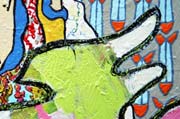 |
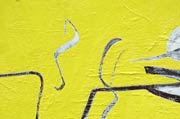 |
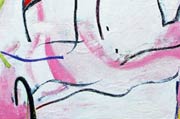 |
 |
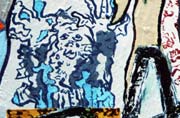 |
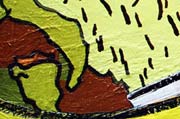 |
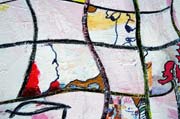 |
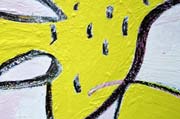 |
 |
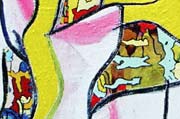 |
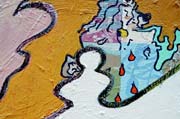 |
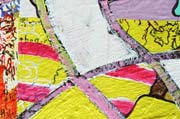 |
And so, with this post of details, “Goya Moment” week concludes at TINSQUO.
This painting is conceived to function across scales, implicitly positing that there is no privileged point of view other than the one you’re currently experiencing.
In the artblog entrance to the painter’s life, consider this post a virtual hoisting of a mug at a cyber Cedar Tavern. Thanks for lingering with me in this pause before attention turns to the next canvas.
For a recap, see the prior entry of states and the time-lapse DV of the painting’s creation (QT 8.5).
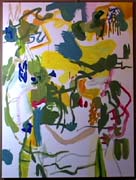 |
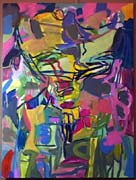 |
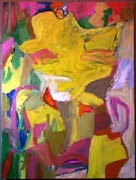 |
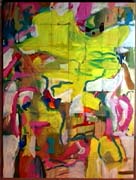 |
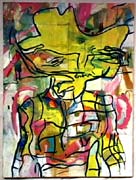 |
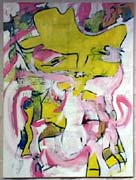 |
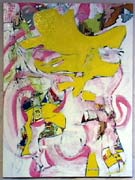 |
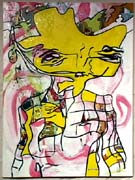 |
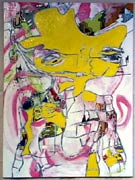 |
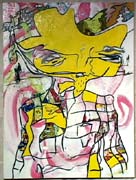 |
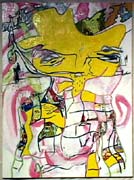 |
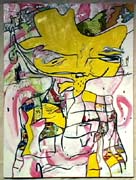 |
Here's a selection of some of the key states of "Goya Moment." For a while, I felt confident the painting was finished as it appears in the tenth state, above. But that was wishful thinking.
There are no shortcuts. The painting decides when it's done.
For all the intervening phases of development, see the time-lapse DV (QT 8.5 MB).
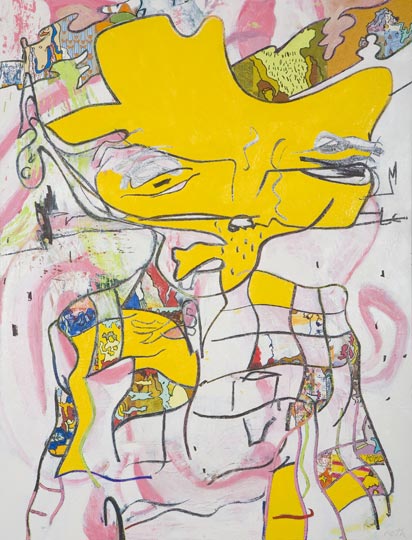
This painting is the whole reason I dreamed up TINSQUO.com. A culmination of months of studio work, "Goya Moment" is a fulfillment of the vision behind this site. It brings the longterm processes at work within the artblog to a momentary resolution.
For elucidation on TINSQUO processes, see Narrative on the "about" page.
Details:
Process Video:
States:
Jimmie Dale Gilmore cautioned us that the late set of an evening can be “weird" last night at Joe’s Pub. He then, happily, went about proving himself prescient.
When the curtains parted for his "Come On Back” CD release party, he ascended to the stage looking spectral. Several years since I’d heard that inimitable voice directly, I felt strangely nervous. He approached the microphone delicately, breathing lyrics as if setting something carefully on a shelf.
So it began.
He launched into a CD sampler of his father’s favorite songs from the new release. Listening, I felt him sift for clues to any wisdom he’d been blind to in younger years, maybe still unsure it was ever there.
About the sweeping intensity of these times, he mused on maturity: “Is it weirder than it used to be or am I just getting more observant?”
Three generations of Gilmores are present on this tour: Jimmie, his son Colin (both opening the show and accompanying on guitar) and the guiding spirit of a deceased patriarch. What his dad “loved more than... anything” lives on, prompting Jimmie to observe that “songs last longer than we do.”
In a native trickster mood, Jimmie paraphrased a complex Bertrand Russell quote with - “There’s no way to prove the universe wasn’t created five minutes ago, complete with memories.”
Each song - interpreted by Gilmore’s placeless echo - floated amidst this wry calm.
I guess I can’t predict how long I’ll remember Tuesday’s concert, but I know I’ll never forget it.
While walking down Park Avenue yesterday, I was stopped in my tracks by the Apocalypse.
More precisely, I was riveted in place by "Apocalypse,” the immense (12’ x 28’) Barnaby Furnas painting currently inhabiting the lobby of the Lever House.
In its scale and subject, the work echoes Anselm Kiefer’s charred history landscapes. Unlike the German master, though, Furnas’s painting is reportage - not elegy - and very American.
The triumphs of heraldic New York School painting resonate on this canvas with the pathos of a dream once dreamed, then deferred and now turned nightmarish. The transcendent “zips” of Barnett Newman turn sinister, delivering blows at their termini and trails of burning phosphorus glowing in their wake. Paint splatters register as messy, explosive incidents of sacrificed bodily integrity. A sea of red roils, beings writhe and souls depart.
It is an all-over painting of video-game grade mayhem dressed up in acrid red, white and blue.
As I lingered before Furnas’s 2005 painting, I noticed that the trauma wrought by its imagery steadily ebbed. In its place rose a dawning perception of the innate beauty of a painter passionately at work. Probably, that’s what actually grabbed my attention in the first place.
Even the image of the Apocalypse won't survive the Apocalypse. Everything is always at stake. Furnas’s painting seems a pre-emptive act of beauty aimed to ward off terminal indifference. So it is with every artist who accepts custodianship of the visions in their trust.
On Thursday, October 20th, Barnaby Furnas will give a free Artist Talk at NYU’s Steinhardt School of Education.